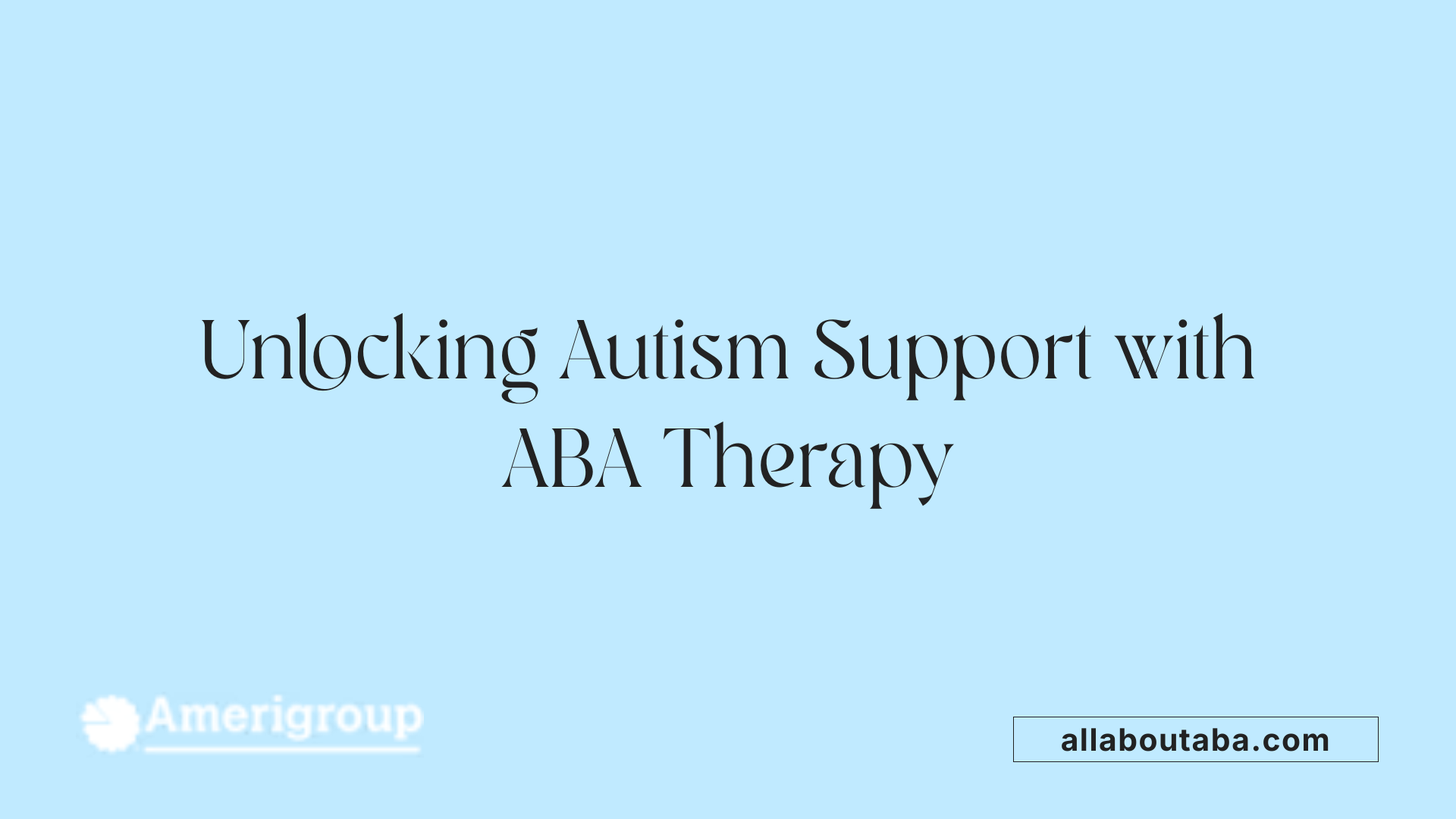Best Ways To Foster Collaboration Between Parents And Schools For Autism Support
Collaboration as the Cornerstone of Autism Support
Effective autism support programs are grounded not only in evidence-based therapies like Applied Behavior Analysis (ABA) but also in strong, ongoing collaboration between parents and schools. This article explores proven strategies and key components that foster productive partnerships, amplifying the benefits of behavioral interventions for children with autism across home and educational settings.
Understanding Applied Behavior Analysis (ABA) Therapy and Its Role in Autism Support

What is Applied Behavior Analysis (ABA) therapy?
Applied Behavior Analysis (ABA) therapy is an evidence-based approach designed to support children with autism and other developmental disorders. ABA focuses on understanding how behavior works and applying learning principles to increase helpful behaviors while decreasing harmful or disruptive ones. This therapy involves detailed assessments to identify individual needs, develop tailored goals, and implement customized interventions.
What are the key ABA techniques?
ABA utilizes several techniques such as positive reinforcement, prompting, and systematic data collection. Positive reinforcement rewards desirable behaviors to encourage repetition. Prompting guides the child toward the correct response, which is gradually faded. Functional behavioral assessments (FBAs) help identify the reasons behind challenging behaviors, guiding intervention strategies effectively. Methods like Discrete Trial Training (DTT) and Natural Environment Teaching (NET) are commonly used within therapy sessions.
How are goals set and treatments planned in ABA?
ABA programs are personalized, with goals uniquely set to match each child's skills and challenges. Continuous progress monitoring allows therapists to adjust plans as needed. Strategies focus on prevention, teaching new skills, and responding appropriately to behaviors. This customization ensures that interventions are meaningful and applicable across various settings such as home, school, and community.
Who delivers ABA therapy?
ABA therapy is provided by trained professionals including Board Certified Behavior Analysts (BCBAs) and Registered Behavior Technicians (RBTs). BCBAs design and supervise treatment plans, ensuring interventions meet professional standards. Collaboration with families is a cornerstone, with parents actively involved in planning, training, and carrying out strategies to reinforce learning and behavior.
Where is ABA therapy delivered?
ABA services take place across multiple environments — at home, in schools, and within community settings. This multi-setting approach promotes the generalization of skills and behaviors, making the learning applicable to everyday life. Inclusion of peers and siblings in intervention activities can further enhance social interaction and skill development.
What research supports ABA effectiveness?
Decades of research support ABA as a best practice treatment for autism spectrum disorder. Studies demonstrate that intensive, long-term ABA therapy (typically 25–40 hours per week over 1 to 3 years) improves communication, intellectual functioning, daily living skills, and social behaviors. Early intervention shows significant benefits in skill acquisition and behavior reduction, with positive effects observed across different therapists and environments.
| Aspect | Details | Importance |
|---|---|---|
| Techniques | Reinforcement, prompting, FBA, DTT, NET | Facilitate learning and behavior change |
| Professionals | BCBAs, RBTs | Ensure quality and tailored interventions |
| Settings | Home, school, community | Promote generalization and real-world skills |
| Research Findings | Proven effectiveness for language, social, and behavior | Supports use as an evidence-based intervention |
| Family Involvement | Active collaboration and training | Enhances success and continuity between settings |
Benefits of Behavioral Analysis for Individuals with Autism

How can behavioral analysis benefit individuals with autism?
Applied Behavior Analysis (ABA) therapy offers profound benefits for individuals with autism by focusing on how behaviors are influenced by environmental factors. ABA helps identify the triggers and outcomes of behaviors, known as antecedents and consequences, enabling the design of targeted interventions that encourage positive behaviors and reduce challenging ones.
Understanding behavior through environmental factors
ABA breaks down behaviors to understand what causes them and what maintains them. By analyzing this, therapists can develop functional behavior assessments (FBAs) that uncover the reasons behind a child's behavior, making interventions more effective.
Targeted interventions to promote positive behavior
Using techniques like positive reinforcement and structured teaching methods—such as discrete trial training (DTT) and natural environment teaching (NET)—ABA aims to increase helpful behaviors including communication, social interaction, and daily living skills. These methods ensure children acquire meaningful skills relevant to their lives.
Customization and adaptability of ABA
ABA programs are highly individualized, with goals tailored to each child's unique needs. Whether delivered at home, school, or community settings, ABA adapts to various environments to fit the child’s lifestyle and promote consistent learning and behavior change.
Generalization of skills across settings
One of ABA’s strengths is helping children apply learned skills beyond therapy sessions. Interventions incorporate strategies like visual schedules, peer and sibling involvement, and family collaboration to ensure skills transfer to untrained routines and real-life situations.
Impact of early intensive intervention
Early, intensive ABA therapy (around 20-40 hours per week) supports significant improvements in intellectual functioning, language development, and social skills. Initiating therapy early maximizes developmental outcomes and can reduce the need for later interventions.
Ongoing monitoring and treatment adjustment
ABA relies on continuous data collection to monitor progress and adjust treatment plans accordingly. This ensures interventions remain effective over time and meet evolving goals, supported by collaboration among therapists, families, and educators.
Below is a table summarizing these key facets:
| Aspect | Description | Benefit |
|---|---|---|
| Environmental Analysis | Identifying antecedents and consequences | Precise intervention targeting |
| Positive Reinforcement | Rewarding desirable behavior | Increases helpful behaviors |
| Individualized Planning | Customized goals and strategies | Meets unique needs |
| Skill Generalization | Applying skills across settings | Real-life application |
| Early Intensive Therapy | High hours/early start | Maximized developmental gains |
| Continuous Data Monitoring | Regular assessment and adjustments | Sustained progress and treatment fidelity |
By emphasizing these benefits, behavioral analysis, particularly ABA, is an evidence-based approach that significantly improves the lives of individuals with autism.
Key Professionals Delivering Autism Therapy and Behavioral Analysis

Who provides therapy focusing on autism and behavioral analysis?
Therapy for autism and behavioral analysis is delivered by trained professionals, chiefly Board Certified Behavior Analysts (BCBAs) and Registered Behavior Technicians (RBTs). BCBAs hold specialized certifications focused on Applied Behavior Analysis (ABA) and possess advanced training to develop, oversee, and modify individualized treatment plans tailored to each child's unique needs.
Roles of Board Certified Behavior Analysts (BCBAs) and Registered Behavior Technicians (RBTs)
BCBAs act as the lead experts who design behavioral interventions based on thorough assessments, such as Functional Behavioral Assessments (FBAs). They determine the function of behaviors and create comprehensive plans that use prevention, teaching, and response strategies to be applied across settings. RBTs carry out these intervention plans under BCBA supervision, delivering direct therapy sessions with children, implementing ABA techniques, and collecting data to track progress.
Specialized training and certifications
BCBAs must complete formal education, supervised experience, and pass certification exams, ensuring adherence to professional standards. RBTs are trained in specific ABA methods and regularly monitored by BCBAs. This credible certification guarantees that therapists utilize evidence-based approaches effectively and ethically.
Development and supervision of individualized treatment plans
BCBAs tailor goals based on behavioral assessments and collaborate with families to integrate preferences and needs into therapy. These plans often include a variety of ABA interventions, such as Discrete Trial Training (DTT), Natural Environment Teaching (NET), Verbal Behavior training, and pivotal response treatment methods. Progress is meticulously monitored through data collection to adjust strategies as necessary.
Collaboration with families and schools
Active family involvement is emphasized, with therapists partnering closely with parents and educational staff to support consistency across home and school environments. This collaboration facilitates generalization of skills and ensures that strategies are consistently applied, reinforcing the child's development and positive behaviors.
Use of evidence-based ABA techniques across environments
Interventions employ reinforcement principles, prompting, visual schedules, and behavior contracts adapted for multiple settings to foster improvements in communication, social skills, and adaptive behaviors. Utilizing peers and siblings in therapy sessions is also common to promote social interaction and generalize skills.
Effective Applied Behavior Analysis Therapy: What Makes It Work?

What makes Applied Behavior Analysis therapy effective for treating autism?
Applied Behavior Analysis (ABA) therapy stands out as an effective intervention for autism due to its strong scientific foundation and individualized approach. ABA is rooted in the science of learning and behavior, focusing on how behavior operates and its interaction with the environment. This therapy systematically applies principles through techniques such as positive reinforcement, antecedent-behavior-consequence (A-B-C) analysis, and continuous data collection to shape desirable behaviors while decreasing maladaptive ones.
Personalized and measurable goals
ABA programs are personalized to each child's unique needs. Therapists such as Board Certified Behavior Analysts (BCBAs) develop comprehensive, data-driven treatment plans. These plans set clear, measurable objectives to track progress in areas like communication, social skills, and daily living. Each intervention is carefully evaluated across settings and with multiple professionals to ensure effectiveness before involving parents fully in home-based implementation.
Focus on positive reinforcement and environment manipulation
Central to ABA's effectiveness is the use of positive reinforcement, which rewards desired behaviors to encourage repetition. The therapy also manipulates environmental factors to reduce triggers of challenging behaviors and promote learning. Approaches like discrete trial training (DTT) and natural environment teaching (NET) embed learning opportunities during daily routines, enhancing skill acquisition.
Strengths and interests-based interventions
ABA emphasizes building on a child's strengths and preferences. Interventions often integrate the child’s interests and use visual schedules or choices to increase engagement. Additionally, ABA encourages the involvement of peers and family members to model behaviors and promote social interaction.
Reducing harmful behaviors and promoting independence
ABA therapy targets harmful or disruptive behaviors by first determining their function through behavioral assessments like Functional Behavior Assessments (FBAs). Based on this analysis, interventions focus on prevention, teaching alternative skills, and appropriate responses, which fosters independence and improved quality of life.
Multi-setting application and thorough assessment
ABA interventions are flexible and can be generalized to various environments including home, school, and community settings. Families, teachers, and therapists collaborate closely to ensure strategies are consistent and effective across these contexts. Continuous monitoring and adjustment of treatment plans allow for sustained progress and support.
| Aspect | Description | Importance |
|---|---|---|
| Scientific foundation | Based on behavior science principles and evidence-based practices. | Ensures reliability and measurable outcomes. |
| Personalized goals | Tailored treatment goals for each child's unique abilities and needs. | Facilitates meaningful progress. |
| Positive reinforcement | Rewards to increase desired behaviors. | Enhances motivation and engagement. |
| Environment manipulation | Adjusts setting to encourage learning and reduce triggers. | Supports generalized behavior change. |
| Strengths-based approach | Incorporates child’s interests and peer involvement. | Boosts participation and social skills. |
| Multi-setting evaluation | Emphasizes consistency at home, school, and community. | Promotes lasting, transferable skill use. |
The Crucial Role of Family Involvement in Autism Interventions
Family as Primary Influencers in a Child's Life
Parents are recognized as the most influential individuals in their child's life, especially for children with autism. Their active engagement plays a pivotal role in behavioral therapy and the development of independence. This familial influence provides a stable foundation for growth and learning across various environments.
Enhancing Intervention Success through Parental Input
Interventions such as Positive Behavior Support (PBS) and Applied Behavior Analysis (ABA) benefit significantly when parents contribute their knowledge about their child's preferences and long-term goals. Their input helps tailor therapy programs that are meaningful and effective, leading to better behavioral outcomes.
Collaborative Goal Setting with Families
A collaborative approach between parents and certified behavior analysts (BCBAs) fosters goal alignment and mutual trust. Regular communication during the therapy process encourages shared decision-making, ensuring interventions are consistent and focused on the child's unique needs.
Parent Training and Support Programs
Programs designed to train and support parents empower families by enhancing their understanding of autism and equipping them with practical skills. These initiatives, often offered by centers like Radiant Autism Center, build parental confidence to support their child’s development effectively.
Parents Empowered to Implement Strategies at Home
Therapists engage parents in coaching and ensure interventions are evaluated for efficacy before home implementation. This process reinforces behavioral gains across settings, leveraging tools like visual schedules and positive reinforcement to maintain progress in natural routines.
Together, these strategies emphasize the indispensability of families in successful autism interventions, ensuring that therapy extends beyond the clinical setting into everyday family life.
Building Collaborative Partnerships Between Parents and Schools
Why Is Family–School Collaboration Integral in Autism Intervention?
Family–school collaboration forms the foundation for successful behavioral interventions in children with autism. Involving families in the intervention process bridges the gap between home and school environments, ensuring consistency and promoting better behavioral outcomes. When parents and educators work together, the child's needs are understood from multiple perspectives, enhancing the quality of individualized support.
How Does Joint Planning, Training, and Implementation Work?
Effective collaboration involves families and school staff jointly planning the intervention strategies based on the child's unique behaviors and preferences. Training sessions equip both parents and teachers with skills to implement behavior support plans accurately. This unified approach ensures that strategies are consistently reinforced across settings, fostering skill generalization and reducing problem behaviors.
What Role Do Team-Building and Person-Centered Planning Play?
Creating a collaborative team, which includes parents, teachers, therapists, and sometimes peers, is crucial. This team engages in person-centered planning that respects the child's individual strengths, interests, and needs. Functional behavioral assessments (FBAs) help the team identify the underlying causes of behaviors and develop targeted strategies tailored to the child.
Why Are Regular Communication and Mutual Trust Essential?
Open and regular communication nurtures mutual trust between families and schools. Sharing progress updates, challenges, and successes helps address issues promptly and reinforces the partnership. Trust encourages families to actively participate and share insights that benefit the child's intervention.
How Are Families Included in Creating Behavior Support Plans?
Families are actively involved in designing behavior support plans that consider the function of the child's behavior. They provide valuable information on triggers and effective reinforcers. Strategies focus on prevention, teaching new skills, and appropriate responses to behaviors. This collaborative input ensures the plan is relevant, realistic, and applicable in both home and school settings, leading to improved effectiveness.
| Collaboration Aspect | Description | Impact on Child's Outcomes |
|---|---|---|
| Family–School Collaboration | Joint involvement of families and school personnel | Enhanced consistency and behavioral improvements |
| Joint Planning & Training | Coordinated strategy development and skill building | Effective and unified intervention application |
| Team-Building & Person-Centered Planning | Inclusive team focusing on child's needs | Tailored, meaningful interventions |
| Communication & Trust | Regular updates and open dialogue | Strengthened partnership and timely adjustments |
| Family Inclusion in Support Plans | Integrating family insights and preferences | Plans that are applicable across settings |
Incorporating Functional Behavioral Assessment (FBA) for Personalized Support
Using FBA to Identify Behavior Functions
Functional Behavioral Assessment (FBA) plays a critical role in understanding the reasons behind challenging behaviors in children with autism. By observing and gathering detailed information about when and where behaviors occur, the FBA helps pinpoint the specific functions that these behaviors serve, such as seeking attention, avoiding tasks, or fulfilling sensory needs.
Hypothesis Development on Behavior Causes
Following data collection, therapists and educators develop hypotheses concerning the underlying causes of problem behaviors. These hypotheses guide the creation of intervention strategies that are tailored to address the functional purpose of each child’s behavior rather than merely its symptoms.
Designing Behavior Support Plans Targeting Prevention, Teaching, and Response
Based on the FBA findings and hypotheses, individualized behavior support plans are crafted. These plans focus on three main components: preventing the occurrence of problem behaviors by modifying triggers, teaching alternative, appropriate behaviors that meet the child’s needs, and establishing consistent responses to both positive behaviors and challenges. This comprehensive approach helps promote lasting behavioral change.
Application of Plans in Both Home and School Environments
Critical to the success of these plans is their implementation across multiple settings, including both school and home. Collaboration between families and professionals ensures the strategies are consistently applied, which fosters generalization of positive behaviors and reduces discrepancies between environments.
Importance of Ongoing Assessment
Interventions are not static; continuous monitoring and reassessment are essential. Regular data collection and review enable adjustments to the support plan as the child grows and their needs evolve, ensuring the interventions remain effective and responsive.
This integration of FBA underlines the effectiveness of positive behavior support models in generating meaningful improvements in behavior for children with autism across various contexts.
Intervention Strategies that Promote Inclusion and Skill Generalization
Embedding Child Preferences into Activities
Personalizing activities by incorporating a child's preferences is a powerful way to increase engagement and motivation. This individualized approach aligns with Positive Behavior Support (PBS) methods, encouraging participation and reducing challenging behaviors by making activities more enjoyable and relevant to the child.
Use of Visual Schedules and Choice-Making
Visual schedules serve as clear, predictable guides for children with autism, helping them understand and anticipate daily routines. Providing choice-making opportunities further empowers children, promoting independence and reducing anxiety. Such tools are proven to support smoother transitions and improved compliance.
Increasing Peer and Sibling Involvement
Engaging peers and siblings in therapy and daily activities helps foster social interactions and communication skills. These naturalistic social partners model appropriate behaviors and facilitate skill generalization beyond adult-led sessions, making social learning more effective and enjoyable for the child.
Positive Reinforcement Techniques
Positive reinforcement is foundational in Applied Behavior Analysis (ABA) and PBS. Rewarding desirable behaviors increases their recurrence while supporting skill acquisition. This might include verbal praise, tangible rewards, or access to preferred activities, strengthening motivation and behavioral improvement.
Evidence of Behavior Generalization Across Routines and Community Settings
Research demonstrates that interventions incorporating these strategies contribute to behavior improvements not only during therapy sessions but also across untrained routines and community environments. This generalization underscores the ecological validity and lasting impact of well-designed behavior support plans, benefiting the child's daily life beyond structured intervention.
These intervention components work synergistically to promote inclusion and facilitate skill generalization, enhancing developmental outcomes for children with autism.
The Power of Peers and Siblings in Social Interaction and Learning

Modeling positive behaviors
Peers and siblings play a crucial role in shaping the behavior of children with autism by acting as natural models for positive social interactions. When children observe their peers and siblings engaging in appropriate behaviors, they are more likely to imitate and learn these behaviors themselves, creating a supportive learning environment.
Enhancing peer and sibling engagement
Active involvement of peers and siblings in intervention strategies encourages interactive learning. By embedding preferences into activities and increasing opportunities for peer and sibling participation, children with autism experience meaningful social engagement that enhances their motivation and participation.
Encouraging social skills development
Interactions with siblings and peers foster the development of essential social skills such as communication, turn-taking, and empathy. These natural social settings provide real-world practice opportunities that complement structured therapy sessions.
Supporting skill generalization through natural interactions
The involvement of peers and siblings helps children generalize learned skills across various settings and routines. Since these interactions take place in everyday environments, skills acquired during therapy are reinforced and transferred more effectively beyond clinical settings.
Benefits to both child and social circle
Engaging peers and siblings not only benefits the child with autism by improving behavioral outcomes but also enriches the social circle. It promotes inclusivity, understanding, and strengthens familial and friendship bonds, creating a supportive community around the child.
Parent Training and Support: Empowering Families to Support Development
Programs Designed to Increase Parental Knowledge and Skills
Parent training programs play a crucial role in empowering families of children with autism. These programs are designed to improve parents' understanding of autism and equip them with skills to support their child’s development effectively. By increasing parental knowledge, these programs help families feel more confident and capable in managing their child's unique needs.
Training Parents in Behavior Management Tools
Parents learn to use evidence-based behavior management strategies such as positive reinforcement, visual schedules, and behavior contracts. These tools help parents address challenging behaviors while promoting skill acquisition. Training includes teaching parents how to implement these strategies consistently across settings, ensuring that children receive coherent support both at home and in other environments.
Importance of Understanding Autism for Effective Support
A thorough understanding of autism spectrum disorder is essential for parents to provide meaningful support. Parent education often focuses on explaining the nature of autism, how behaviors develop, and the rationale behind specific interventions. This knowledge helps parents become active partners in therapy and advocates for their child's needs.
Partnering with Professionals for Coaching and Feedback
Collaboration between families and trained professionals, such as Board Certified Behavior Analysts (BCBAs), is vital. Professionals provide coaching, model intervention strategies, and offer ongoing feedback to parents. This partnership supports skill generalization and ensures that interventions are implemented effectively within daily routines.
Impact of Parental Involvement on Therapy Outcomes
Research consistently shows that parental involvement enhances the effectiveness of behavioral therapies like Applied Behavior Analysis (ABA). When parents actively participate in training and intervention, children show greater improvements in communication, social skills, and reduction of challenging behaviors. This active engagement fosters consistency and reinforces progress across all settings.
Early Detection and Intervention in Autism: The Parent's Role
Why is early identification important?
Early detection of autism spectrum disorder (ASD) is crucial as it opens the door to immediate support and intervention. Identifying autism symptoms early enables children to access therapy during a critical period of brain development, which can lead to better communication, social skills, and behavioral outcomes.
How do parents participate in early diagnosis and therapy?
Parents are often the first to notice developmental differences and are vital partners in both diagnosis and intervention. Their involvement includes sharing observations during evaluations, participating in parent training programs, and supporting therapy goals at home. Empowering parents with knowledge about autism strengthens their ability to advocate for their child and engage effectively in treatment.
What are the benefits of early intensive ABA therapy?
Applied Behavior Analysis (ABA) therapy, when started early and delivered intensively (often 25-40 hours per week), has been shown to significantly improve language, communication, and adaptive behaviors in children with autism. Early intervention maximizes skill acquisition and helps reduce challenging behaviors, promoting greater independence and social functioning.
How does collaboration with professionals improve outcomes?
Successful early intervention depends on close collaboration among parents, healthcare providers, behavior analysts, and educators. This teamwork ensures comprehensive assessments, individualized treatment planning, and consistent implementation of strategies across settings, enhancing the child’s developmental progress.
How does early support affect developmental trajectories?
With timely and consistent early intervention, children with autism can experience improved developmental trajectories, including better intellectual functioning, social skills, and daily living abilities. Parental involvement combined with evidence-based therapies like ABA fosters these positive outcomes by reinforcing learning in both clinical and home environments.
Sustaining Progress Through Continuous Collaboration and Assessment
Ongoing Data Collection and Progress Monitoring
Effective behavior interventions rely heavily on systematic data collection. In ABA therapy for children with autism, therapists continuously collect data on behaviors to monitor progress and make evidence-based decisions. This ongoing tracking enables individualized adjustments and ensures therapy remains aligned with the child’s evolving needs.
Regular Review and Adjustment of Goals
Behavioral goals are not static; they require frequent reassessment. Collaborative teams—comprising BCBAs, educators, and families—periodically review intervention outcomes to refine objectives. This ensures goals remain meaningful and achievable, fostering sustainable improvements.
Maintaining Shared Responsibility Between Parents and Educators
Strong family–school collaboration is critical. Parents and educators share responsibility for implementing strategies consistently across settings. This unified approach promotes generalization of learned skills and reduces problem behaviors both at home and school.
Leveraging Multidisciplinary Teams for Comprehensive Support
Comprehensive care often involves multidisciplinary teams including behavior analysts, teachers, therapists, and family members. This team-building approach allows for person-centered planning and functional behavioral assessments, ensuring strategies are tailored and holistic.
Ensuring Consistency Across Home, School, and Community Settings
Consistency in intervention strategies, such as visual schedules and positive reinforcement, across all environments maximizes effectiveness. Generalization of positive behaviors to untrained routines and community settings underscores the ecological validity of interventions.
Together, these strategies form a dynamic support system that sustains progress and enhances the developmental outcomes for children with autism.
Towards Holistic Autism Support Through Unified Partnership
The foundation of successful autism interventions lies not only in evidence-based therapies like ABA but in forging strong, trusting collaborations between parents and schools. Active family involvement, combined with professional guidance and continuous communication, ensures interventions are personalized, consistent, and effective across all environments. Emphasizing teamwork, shared goals, and empowerment of families creates a nurturing framework where children with autism can thrive socially, academically, and emotionally. As research and practice continue to evolve, embracing these collaborative strategies remains essential for fostering meaningful progress and inclusion throughout childhood and beyond.
References
- (PDF) Positive Behavior Support Through Family-School ...
- How Our Autism Program With Parent Support Makes A ...
- Applied Behavior Analysis (ABA)
- Effective Collaboration Between Parents and BCBAs
- What Is ABA Therapy? A Beginner's Guide for Parents
- Applied Behavior Analysis (ABA)
- Applied Behavior Analysis (ABA)
Other articles
Recent articles

Best Ways To Foster Collaboration Between Parents And Schools For Autism Support

Supporting Autistic Children During Transitions Between Activities

The Role Of Teachers In Fostering Autism Peer Acceptance

Using Art Therapy To Support Children With Autism

Autism And Strategies For Addressing Sensory Defensiveness

Autism And The Benefits Of Structured Leisure Activities

How To Support Autistic Students During Exam Season

Autism And Goal Setting For Personal Growth

How To Use Gamification In Autism Learning Programs

How Schools Can Reduce Bullying Of Autistic Students

Early Intervention Strategies For Autism Spectrum Disorder

The Role Of Therapists In Autism Life Skills Coaching

How To Support Autistic Individuals In Crisis Situations

Autism And Self-Care Routines For Stress Management

Understanding Echolalia And Its Role In Autism Communication

Autism And Fine Arts Education Benefits

The Impact Of Multisensory Learning On Autism Education

How Family Counseling Supports Autism Household Dynamics

Best Practices For Inclusive Playgrounds For Autism

Best Practices For Autism-Friendly Shopping Centers

How Autism Affects Fine Motor Skill Development

Best Ways To Introduce Sensory Activities Into Daily Routines

How Sports Teams Can Be Inclusive Of Autistic Players

Autism And Strategies For Building Workplace Resilience

Autism And The Impact Of Hormonal Changes During Puberty

How To Support Autistic Students In Foreign Language Classes

Best Ways To Teach Money Skills To Teens With Autism

Supporting Siblings Of Children With Autism

Autism And Co-Occurring Gastrointestinal Disorders

The Role Of Art Projects In Autism Sensory Integration

How Schools Can Incorporate Sensory Break Spaces

Best Practices For Autism Sensory Regulation At School

Autism And Strategies For Teaching Organizational Skills

Understanding The Relationship Between Autism And Anxiety Disorders

Autism And Life Planning For Long-Term Care

Exploring Visual Supports In Autism Education

Ways To Encourage Social Interaction In Children With Autism

The Connection Between Autism And Dyscalculia

The Role Of Occupational Therapy In Transition Planning For Autism

The Role Of Physical Therapists In Autism Motor Skills Support

How To Teach Decision-Making Skills To Autistic Young Adults

The Connection Between Autism And Epilepsy

Best Practices For Transitioning Autistic Children Into New Schools

Autism And Time Management Challenges In Adulthood

The Role Of Visual Arts In Autism Communication Development

How To Address Tactile Defensiveness In Autism

Best Practices For Telehealth Autism Therapy

How To Help Autistic Children Develop Friendship Skills

How Schools Can Support Autistic Students In Career Prep

Best Strategies For Autism-Friendly Event Planning

Understanding Noncontingent Reinforcement In Autism Behavior Plans

How Drama Therapy Benefits Autistic Individuals

Best Practices For Autism-Friendly Fitness And Recreation Centers

Best Ways To Promote Healthy Social Media Use For Autistic Teens

How To Help Autistic Children Cope With Public Speaking

Autism And Strategies For Managing Unexpected Changes

Best Podcasts About Autism For Parents And Educators

Autism And The Impact Of Seasonal Changes On Behavior

The Role Of Diet In Managing Co-Occurring Conditions With Autism

Sleep Challenges In Autism And Practical Solutions

Best Ways To Build Daily Routines For Autistic Children

Best Practices For Supporting Autistic Entrepreneurs

Autism And Strategies For Navigating Large Social Gatherings

Adaptive Sports And Recreational Activities For People With Autism

Autism And The Benefits Of Story-Based Learning Activities

Understanding The Role Of Play In Autism Development

Autism And The Impact Of Environmental Noise On Learning

How To Create Autism-Friendly Community Spaces

Autism And Chronic Health Conditions: What To Know

The Role Of Care Managers In Autism Life Planning

How To Teach Social Boundaries To Autistic Children

How Autistic Individuals Experience Empathy Differently

How To Support Autistic Employees In Remote Work Settings

Autism And The Relationship Between Motor Skills And Learning

How To Create Community Resource Guides For Autism Families

How To Teach Daily Living Skills To Autistic Teens

Autism And The Impact Of Mind-Body Practices On Stress Reduction

Autism And The Benefits Of Outdoor Group Activities

How To Create Autism-Friendly Sensory Paths In Schools

Best Practices For Autism-Friendly Park And Recreation Areas

Autism And Strategies For Reducing School Refusal

Supporting Autistic Individuals In Public Speaking

The Role Of Diet In Managing Autism Symptoms

The Benefits Of Gardening Clubs For Autism Social Development

How To Prepare Autistic Children For Dental Visits

Autism And Employment: Career Paths That Work

Best Practices For Autism-Friendly Hotels And Lodging

The Impact Of Screen Time On Autism Development

Autism Screening Tools For Early Childhood

The Role Of Physical Exercise In Autism Therapy

Best Strategies For Supporting Autistic College Students

The Role Of Technology In Autism Early Detection

Sensory-Friendly Classroom Design Ideas For Autistic Students

The Role Of Speech Therapy In Building Social Communication Skills

Best Strategies For Handling Autistic Burnout In Adults

Autism And The Importance Of Predictability In Routine

Autism And Peer Education: Teaching Acceptance In Schools

Best Practices For Sensory-Friendly Libraries And Reading Rooms

Self-Advocacy Skills For Autistic Adults

The Role Of Technology In Autism Peer Communication
We’re All About You, Your Family, and Your Child

